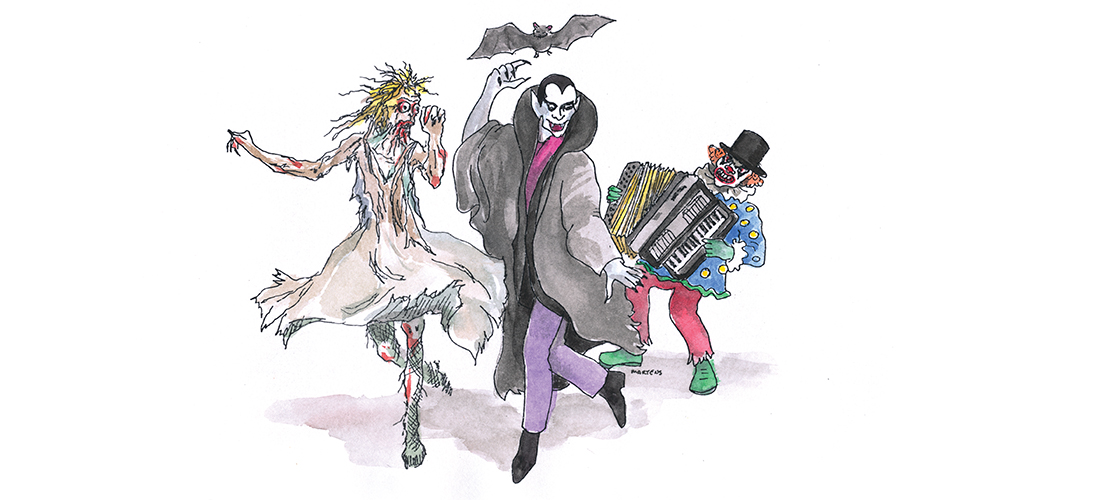
The State of Mystery
Across North Carolina, tales of unexplained happenings abound — and delight — come October
By Tom Allen
If ghosts and graveyards peak curiosity, October is your month. Check local listings for all things haunted or headless. Since Washington Irving penned his scary legend in 1820, “Sleepy Hollows” abound. I recall a couple of childhood nightmares, courtesy of Ichabod Crane.
Now that I’m grown up, lions and tigers and bears are a piece-a-cake. But vampires and zombies? Jeepers creepers! I likewise recoil from chainsaw murderers and psychotic clowns. Social media and 24/7 breaking news merge reality with fiction. I don’t need another autopsy on NCIS or Criminal Minds to remind me how palpable sadness and tragedy can be.
But I do love a good mystery. What happened to Amelia Earhart? Does the Loch Ness Monster exist? Did a college classmate (who’s sure the 1969 moon landing was staged) really encounter Bigfoot on a camping trek to Oregon?
From Murphy to Manteo, North Carolina mysteries and legends thrive. Growing up, I heard of a spot in a Chatham County forest: the Devil’s Tramping Ground, a 40-foot ring where nothing has grown for a century and anything left in the ring disappears overnight. I haven’t visited and don’t plan to.
However, I am curious about mermaid sightings, again in Chatham County, where the Haw and Deep rivers merge to form the Cape Fear. An Irishman and Revolutionary War commander, Ambrose Ramsey, opened a tavern near the bonnie banks in the late 1700s. Chaps making their way home after the tavern closed claimed to see mermaids singing, laughing and splashing about off a river sandbar. Stories of sightings continued for more than a hundred years. When flooding destroyed the tavern, those stories disappeared as well.
Oddly, tales of mermaid revelry never originated with fellows headed to the tavern, just after leaving. Ale tales or actual sightings? Who knows? The famous and infamous, from Christopher Columbus to the pirate Blackbeard, reported seeing the mythical creatures at sea. By all accounts, whether far out in the Atlantic or on a Cape Fear sandbar, the encounters — sporadic and brief — were always friendly.
For many North Carolinians, no unsolved mystery has consumed our imaginations, from elementary school years through adulthood, like that of the Lost Colony. In 1587, 117 settlers arrived at Roanoke Island, hoping to establish the first English-speaking colony in the New World. Three years later, delayed because of England’s war with Spain, the colony’s leader, English governor John White, returned with supplies. The colonists were nowhere to be found. A rescue party saw the letters CRO carved into a tree, and later, CROATAN, whittled on a fencepost.
Perhaps Croatan, an island south of Roanoke, inhabited by a Native American tribe of the same name, became the colonists’ new home. Were the settlers welcomed by friendly natives, or was their presence a source of hostility? Were they abducted, killed? Or, did they live out their lives assimilated among the Croatan, or some other native tribe more inland? Did they marry, have children, merge the New World with the Old? In recent years, DNA from locals failed to produce evidence of descendants.
Bad weather forced John White to end his search, a search that failed to locate his daughter, son-in-law and granddaughter, Virginia Dare, the first English child born in this New World. With few clues and lots of bad luck, the lost colonists vanished from history. Archeologists and amateur sleuths continue to ponder the mystery and mystique of what really happened, what might have been.
My theory? Google “Hattadare Indian Nation,” found in my hometown of Bunnlevel. James Lowery, a kind gentleman, also known as Chief Little Beaver, posited that some of the colonists survived, including Virginia, and intermarried with his coastal Native American ancestors, hence the name “Hattadare.” Mystery solved. Or not. But it makes sense to me.
Come Oct. 31, trick-or-treaters of all ages will remind us how much some folks enjoy dressing up and being someone they’re not, especially when fiction, at least for one night, is far from reality. Some may wonder about mermaids or lost people and worlds. Others, like myself, will ponder another mystery, still unsolved — How did a headless horseman find his way through that dark Sleepy Hollow? A horse with a great sense of direction?
Happy All Hallows Eve! PS
Tom Allen is minister of education at First Baptist Church, Southern Pines.





